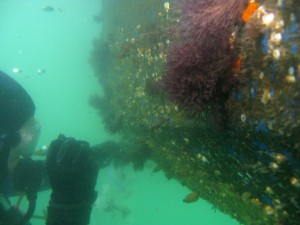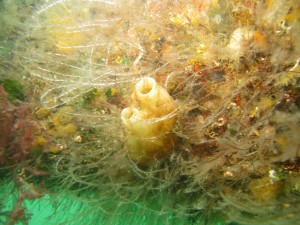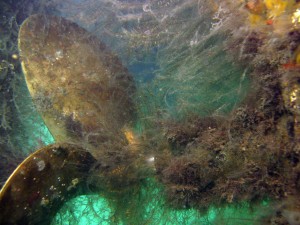by Ian Davidson
If several pounds of plant and animal material were attached to the underside of your car, slowing you down and increasing your fuel costs, you’d probably be concerned enough to remove it. The same applies to boats. But since boaters don’t have easy access to the undersides of their vessels, it can often be a surprise to discover large communities of organisms residing and hitchhiking on their hulls and running gear.
While biofouling can be a real drag for boaters, there’s also an environmental effect of inadvertent biofouling transfers by boats. The movement of fouled boats can lead to the coastal transfer of introduced species and sometimes longer distance primary invasions through long-haul voyages.
Researchers from the Aquatic Bioinvasion Research & Policy Institute, a partnership between the Smithsonian Environmental Research Center (SERC) and Portland State University (PSU), began exploring the links between fouling on recreational boats and the spread of invasive species in 2007. The team, led by Dr. Ian Davidson at PSU, and Drs. Chela Zabin and Gail Ashton at SERC, conduct boater surveys and collect data on the fouling organisms attached to the hulls and niche areas of recreational vessels throughout the West Coast. Their objectives: to determine how much biofouling is attached to boats, what species are within the biofouling communities, what introduced species might be transferred, and how boater behavior and voyage history relates to the biota recorded underwater. So far they have conducted intensive studies in Southern California, Central California, San Francisco Bay and Ketchikan, Alaska.
One study, published in Aquatic Biology in 2010, used a questionnaire of San Francisco Bay boaters to gather information about their vessel, boat maintenance practices and voyage history. Specifically it asked about the type of vessel, its home port, how recently it had been hauled out for cleaning, the type and timing of antifouling paint applications, and its recent voyage information. With permission from the boat owners, another survey was conducted of the hull using an underwater camera mounted to a pole (pole-cam).

A SCUBA diving researcher samples the hull of a heavily fouled recreational boat in California. (Ian Davidson)

The tunicate Styela plicata, along with other non-native organisms clinging to the hull of a boat on the West Coast. (Ian Davidson)
A follow-up study examined the connectivity of boat traffic between San Francisco Bay and adjacent harbors on the central coast of California. This study found that boating patterns provide strong connectivity linking San Francisco with Half-Moon Bay, Bodega Bay, and Monterey Harbor. The researchers recorded eight species that are non-native to central California from 34 vessels sampled. It also noted that the spread of the Asian kelp, Undaria pinnatifida, is likely linked to transfers by recreational boats along the coast of California.
A third study, based in Ketchikan Alaska, examined longer-distance boater movements and biofouling transfers. Ketchikan can be considered a gateway harbor to the rest of Alaska and a key hub of maritime traffic in the State. The study noted a distinct pattern of seasonal (early summer) arrivals to southeast Alaska from southern states – mainly Washington, southern British Columbia and California. Many of the boats involved in this seasonal migration northwards travel over 600 miles from their home ports, providing a significant leap in distribution for many species that could not achieve such a transfer under their own powers of dispersal.
For the in-water portion of this study, the researchers donned their SCUBA gear to collect images and biological samples of biofouling from newly arriving vessels. In all, the dive team surveyed 50 recreational boats during the summers of 2009 and 2010. As with their prior studies, a majority of vessels (62%) had some biofouling associated with their submerged surfaces and some boats had many thousands of sessile organisms. At least nine species were considered non-native to southeast Alaska, including barnacles and bryozoans.
It’s clear that biofouling on recreational boats poses a risk of invasion, but it is also a risky and expensive problem for boaters in terms of their own smooth sailing and fuel costs. Therefore, the benefit of thorough regular maintenance practices can have a double-whammy benefit for the environment and a boater’s bottom line. So, enjoy the views, natural wonders, and mariner community as you voyage while doing your part to protect your boat’s hull and the environment.
Dr. Ian Davidson is a research associate at the Aquatic Bioinvasion Research & Policy Institute, a joint program between Portland State University and the Smithsonian Environmental Research Center. His research focuses on marine and estuarine introduced species and benthic ecology.


